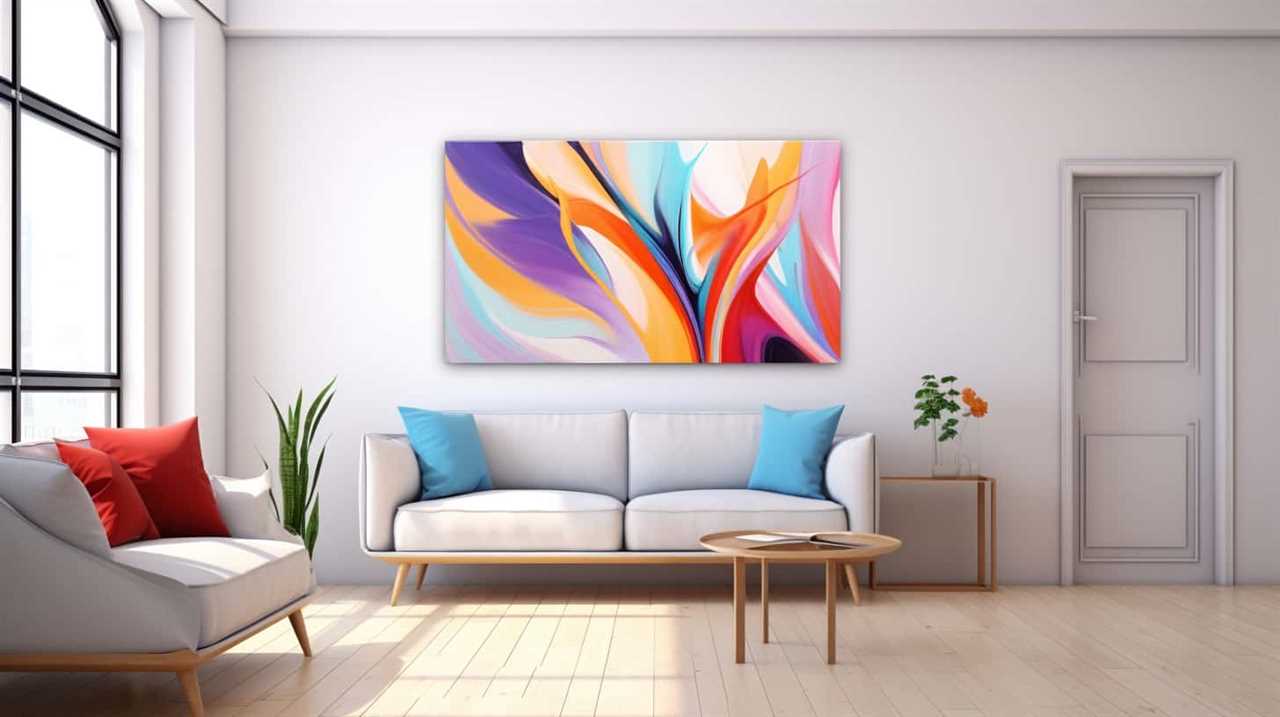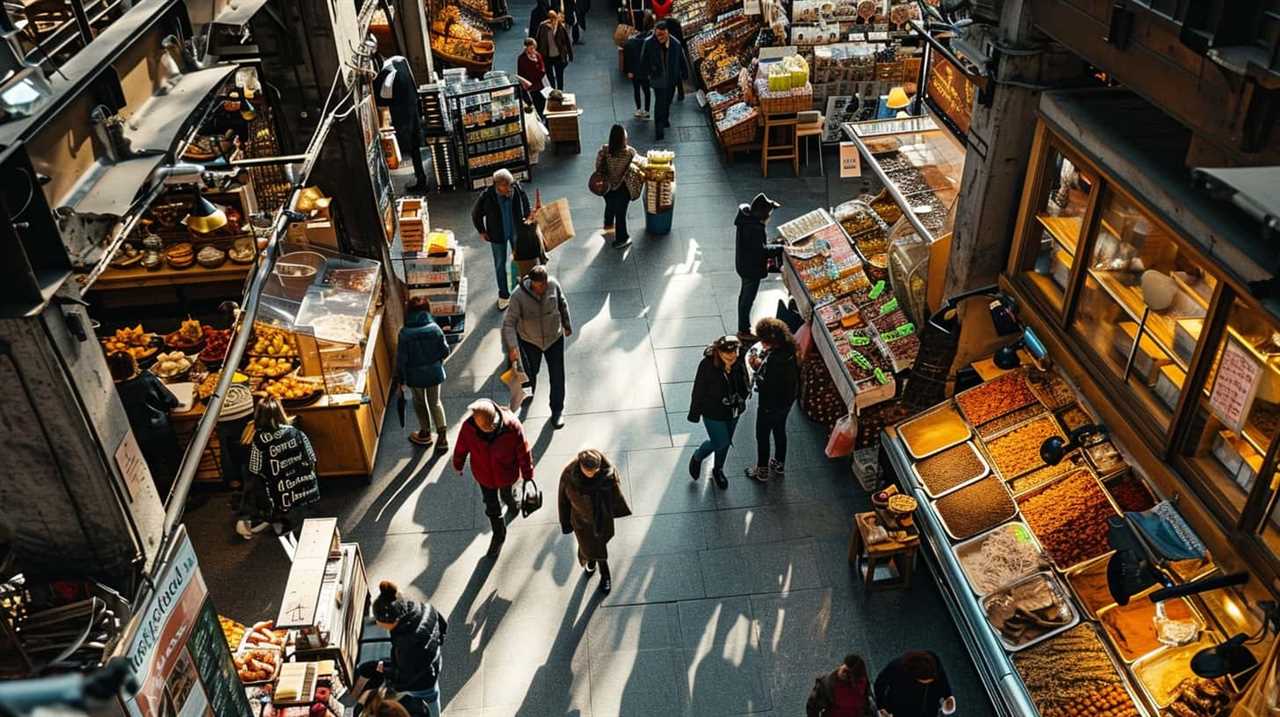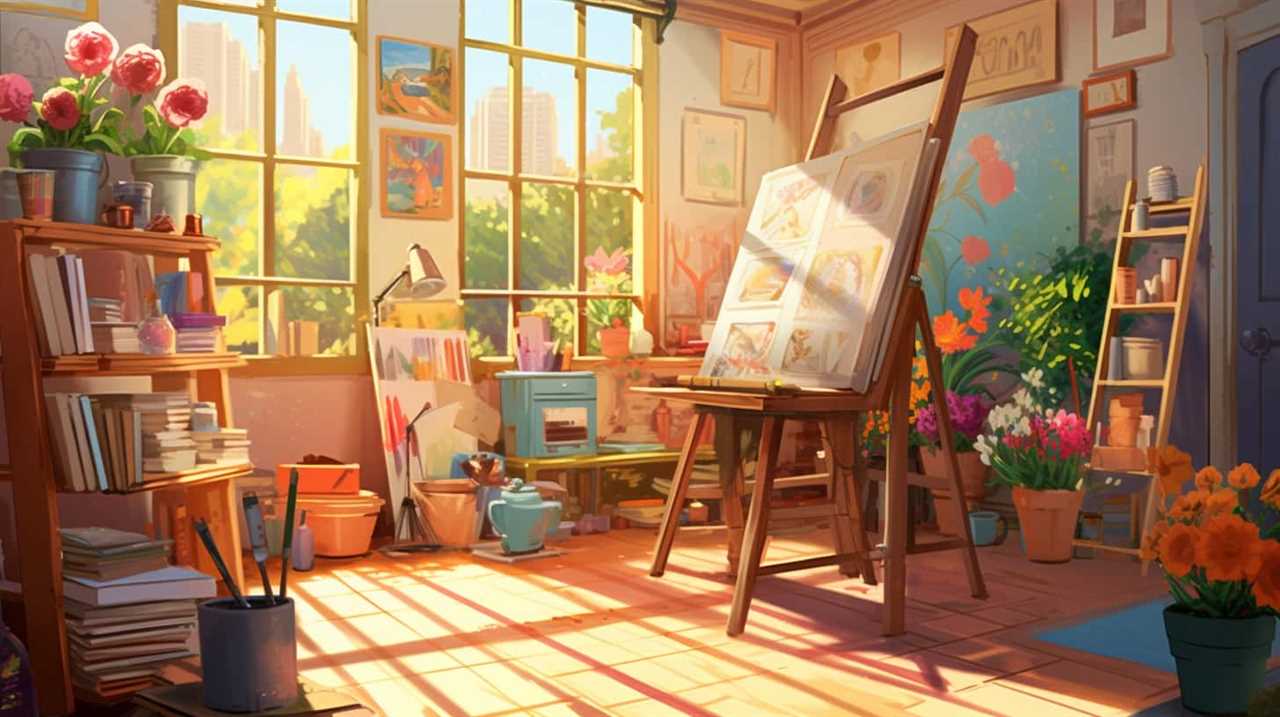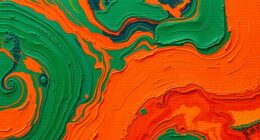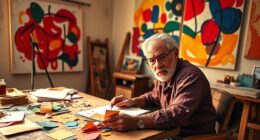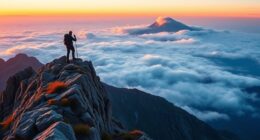Ever thought about how technology has transformed the conversations and interactions around art? Let us enlighten you, it has revolutionized the modern art discourse!
From immersive virtual reality experiences to mind-bending bioart experiments, technology has liberated artists and art enthusiasts alike, propelling us into a new era of artistic expression.
With the advent of digital tools and social media platforms, we now have the power to connect, collaborate, and share our thoughts on art like never before.
And let’s not forget the role of robotics and data visualization, pushing the boundaries of creativity and challenging traditional notions of what art can be.
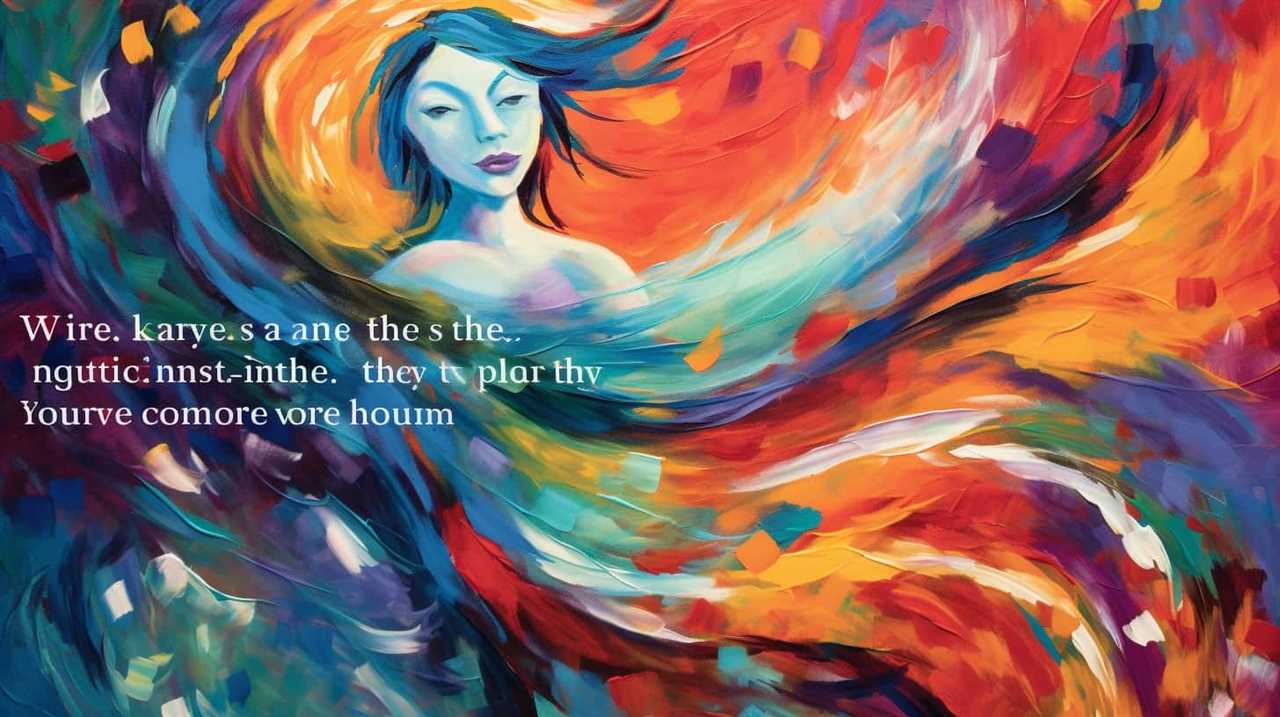
The future of art dialogue is undoubtedly intertwined with technology, and we are here to explore how it continues to shape the vibrant and ever-evolving world of contemporary art.
Key Takeaways
- Technological advancements in art creation and engagement, such as VR and interactive installations, are pushing the boundaries of traditional art forms and revolutionizing audience engagement.
- Social media platforms and online art communities have transformed the way art is discussed, shared, and appreciated globally, promoting inclusivity and collaboration.
- AI algorithms and internet art are redefining artistic boundaries, challenging notions of authorship, and democratizing the art world by providing a platform for diverse artists and voices.
- Technology has fostered accessibility and inclusivity in the art world, allowing for digital accessibility, virtual exhibitions, and the amplification of underrepresented voices in the art community.
Media Artists Exploring Technological Advancements
Our exploration of media artists’ engagement with technological advancements reveals the transformative power of their creativity. These artists have been at the forefront of exploring interactive installations and immersive digital experiences, pushing the boundaries of traditional art forms. Through their innovative use of technology, they’ve revolutionized the way we engage with art and expanded the possibilities of artistic expression.
One example of media artists’ exploration of interactive installations is the work of teamLab, a Japanese art collective. They create immersive environments where viewers become active participants, blurring the lines between the artwork and the audience. By incorporating technology such as motion sensors and interactive projections, teamLab creates a dynamic and engaging experience that challenges traditional notions of art.
Another example is the emergence of virtual reality (VR) as a tool for artistic expression. Artists are using VR to create immersive digital experiences that transport viewers to new worlds and perspectives. This technology allows for a deeper level of engagement and emotional connection, as viewers can physically interact with the artwork and become fully immersed in the artistic narrative.
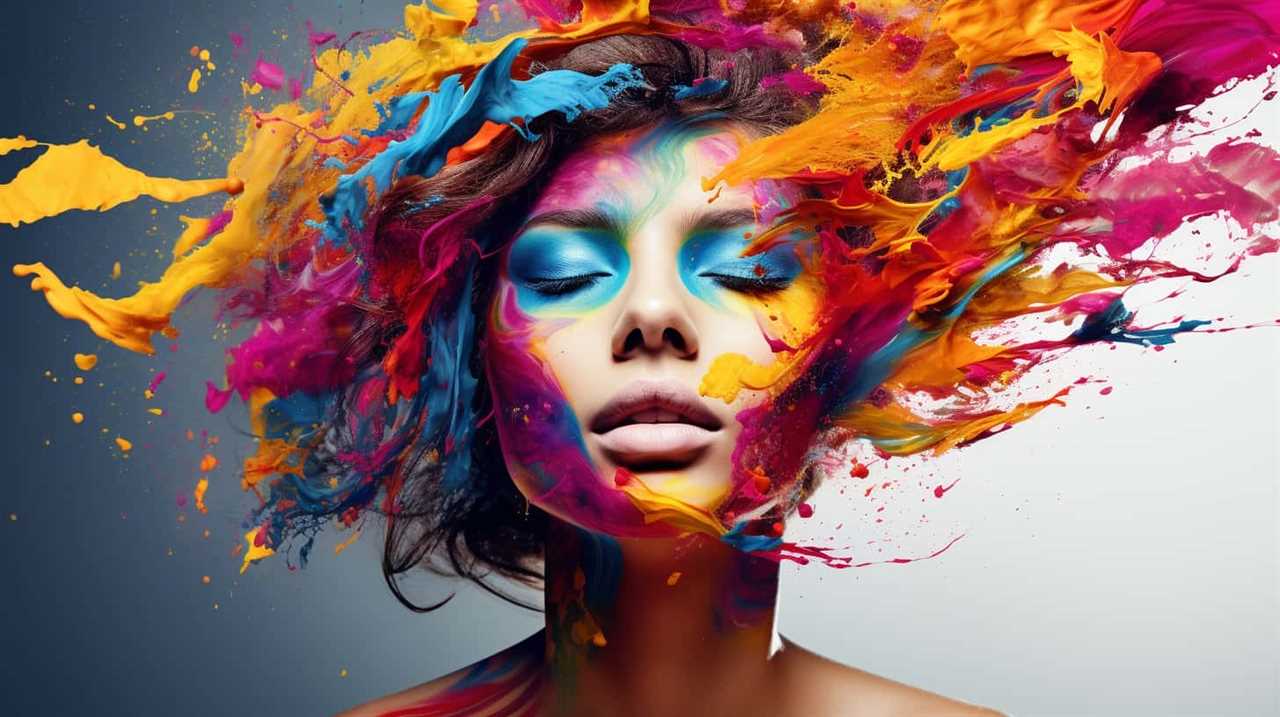
The exploration of interactive installations and immersive digital experiences by media artists has opened up new possibilities for artistic expression and audience engagement. It has liberated art from the confines of traditional mediums and allowed for a more dynamic and interactive experience. As technology continues to advance, media artists will undoubtedly continue to push the boundaries of what’s possible, creating transformative and liberating experiences for audiences around the world.
Impact of Digital Tools on Art Discussions
Digital tools have had a profound impact on the way we engage in art discussions, transforming the way we analyze, interpret, and share artistic experiences. With the rise of social media and digital art communities, the impact of these tools has become even more significant.
Social media platforms such as Instagram, Twitter, and Facebook have provided artists and art enthusiasts with a global platform to share their work, thoughts, and opinions. The immediacy and accessibility of these platforms have increased the reach and visibility of art discussions, allowing for a more inclusive and diverse dialogue.
Digital art communities have also played a crucial role in shaping the way we discuss art. These online platforms bring together artists, critics, and enthusiasts from around the world, fostering a sense of community and collaboration. Through these communities, individuals can engage in conversations, exchange ideas, and provide feedback on each other’s work. This hasn’t only facilitated a deeper understanding and appreciation of art but has also encouraged experimentation and innovation.

As digital tools continue to evolve, they’ve opened up new possibilities for art discussions. One such development is the use of virtual reality as a medium for artistic expression. This emerging technology allows artists to create immersive and interactive experiences that can be shared with a global audience. In the next section, we’ll explore the potential of virtual reality as a transformative tool in art dialogue.
Virtual Reality as a Medium for Artistic Expression
In exploring the transformative potential of art dialogue, we find virtual reality to be a game-changing medium. Virtual reality installations offer a new dimension to artistic expression, allowing viewers to immerse themselves in the artwork and engage with it on a deeply personal level. Here are two ways in which virtual reality is revolutionizing artistic experiences:
- Enhanced Immersion: Virtual reality installations create a sense of presence, transporting viewers into a virtual world where they can interact with the artwork in ways that were previously unimaginable. Through the use of VR headsets and motion-tracking technology, artists can create immersive environments that stimulate multiple senses, making the experience more visceral and engaging.
- Expanded Narrative Possibilities: Virtual reality opens up a realm of possibilities for storytelling and narrative exploration. Artists can create virtual environments that transcend the physical limitations of traditional art mediums, allowing for nonlinear narratives, interactive storytelling, and the blurring of boundaries between artist and viewer.
By leveraging the power of virtual reality, artists can push the boundaries of artistic expression and challenge the conventional notions of what art can be. This medium not only allows for a more immersive and interactive experience but also has the potential to democratize access to art, making it more inclusive and accessible to a wider audience.
Transition: While virtual reality offers a new way to experience and engage with art, social media has also played a significant role in shaping the modern art dialogue.

Social Media and Its Influence on Art Dialogue
Through the widespread use of social media platforms, we’ve witnessed a significant transformation in the way art is discussed and shared among individuals and communities. Social media has created a space where artists, art enthusiasts, and collectors from all over the world can come together and engage in meaningful conversations about art. This has led to the emergence of inclusive online art communities, where people with diverse backgrounds and perspectives can connect and exchange ideas.
One of the key factors contributing to the inclusivity of online art communities is the impact of social media algorithms on art visibility. These algorithms are designed to curate and personalize content for users based on their preferences and interests. This means that individuals who are interested in art are more likely to come across artworks and discussions related to their specific tastes. As a result, artists who may have previously struggled to gain recognition in traditional art circles now have the opportunity to showcase their work to a wider audience.
However, it’s important to acknowledge that social media algorithms also have their limitations. They can reinforce existing biases and preferences, potentially excluding certain artists or art forms from gaining visibility. To address this issue, it’s crucial for platforms and users alike to actively seek out and promote diverse voices and perspectives within online art communities. By doing so, we can ensure that these communities truly embody inclusivity and provide a platform for artists of all backgrounds to share their work and contribute to the ongoing art dialogue.
Augmented Reality’s Role in Contemporary Art Discourse
Our exploration of the transformative impact of social media on art dialogue continues as we delve into the role of augmented reality (AR) in contemporary art discourse. AR has revolutionized the way we experience art, particularly in museum settings, by providing immersive and interactive experiences that push the boundaries of traditional art forms.

- AR’s impact on museum experiences:
- Enhanced engagement: AR allows museum visitors to actively participate in the art by overlaying digital elements onto physical artworks, creating a dynamic and interactive experience. This engagement fosters a deeper connection between the viewer and the artwork, enabling a more meaningful and personal interpretation.
- Expanded narratives: Through AR, museums can now present additional layers of information and narratives about the artworks. This technology enables curators to provide context, historical background, and even artist insights, enriching the viewer’s understanding and appreciation of the art.
- The integration of technology in interactive installations:
- Breaking boundaries: AR blurs the line between the virtual and physical worlds, allowing artists to explore new possibilities in their creations. Artists can now combine digital elements with physical objects to create interactive installations that challenge traditional notions of art and push the boundaries of creativity.
- Empowering the audience: AR installations empower the audience to become active participants in the artistic process. By incorporating technology, artists can create immersive and interactive experiences that invite viewers to co-create and shape the artwork, fostering a sense of agency and liberation.
The Use of AI in Artistic Creation and Interpretation
How can AI revolutionize the creation and interpretation of art in contemporary discourse?
The use of AI algorithms and machine learning in artistic interpretation has the potential to redefine the boundaries of artistic creation and interpretation. AI technologies can analyze vast amounts of data to identify patterns, generate novel ideas, and offer new perspectives. This opens up exciting possibilities for artists to explore and experiment with.
Generative art, which is created using algorithms and AI, has already made a significant impact on the art world. Artists are leveraging AI tools to create artworks that are constantly evolving and changing, challenging traditional notions of authorship and permanence. These AI-generated artworks also provide a unique lens through which to interpret and understand the world around us.
AI can also enhance the interpretation of art by offering insights and analysis that may not be immediately apparent to human viewers. By analyzing patterns and trends across different artworks and artists, AI can uncover connections and themes that can deepen our understanding and appreciation of art.
However, it’s important to approach the use of AI in art with caution. While AI can be a powerful tool, it shouldn’t replace the human experience and creativity. The true value of AI in artistic creation and interpretation lies in its ability to augment and enhance human artistic expression, rather than replace it. As we navigate the intersection of technology and art, it’s crucial to ensure that AI remains a tool for liberation and creativity rather than a substitute for human ingenuity.
Internet Art and Its Impact on the Art World
Internet art has profoundly reshaped the art world, leading to a redefinition of artistic boundaries. The accessibility and inclusivity of internet art have opened up new possibilities for artists and audiences alike, breaking down traditional barriers of entry.
As digital mediums continue to evolve, the debate between digital and traditional art forms becomes increasingly nuanced, challenging preconceived notions of what constitutes art and pushing the boundaries of creativity.
Redefining Artistic Boundaries
We have witnessed a transformative shift in the art world due to the emergence of internet art, which has redefined artistic boundaries and sparked a new era of creativity and accessibility.
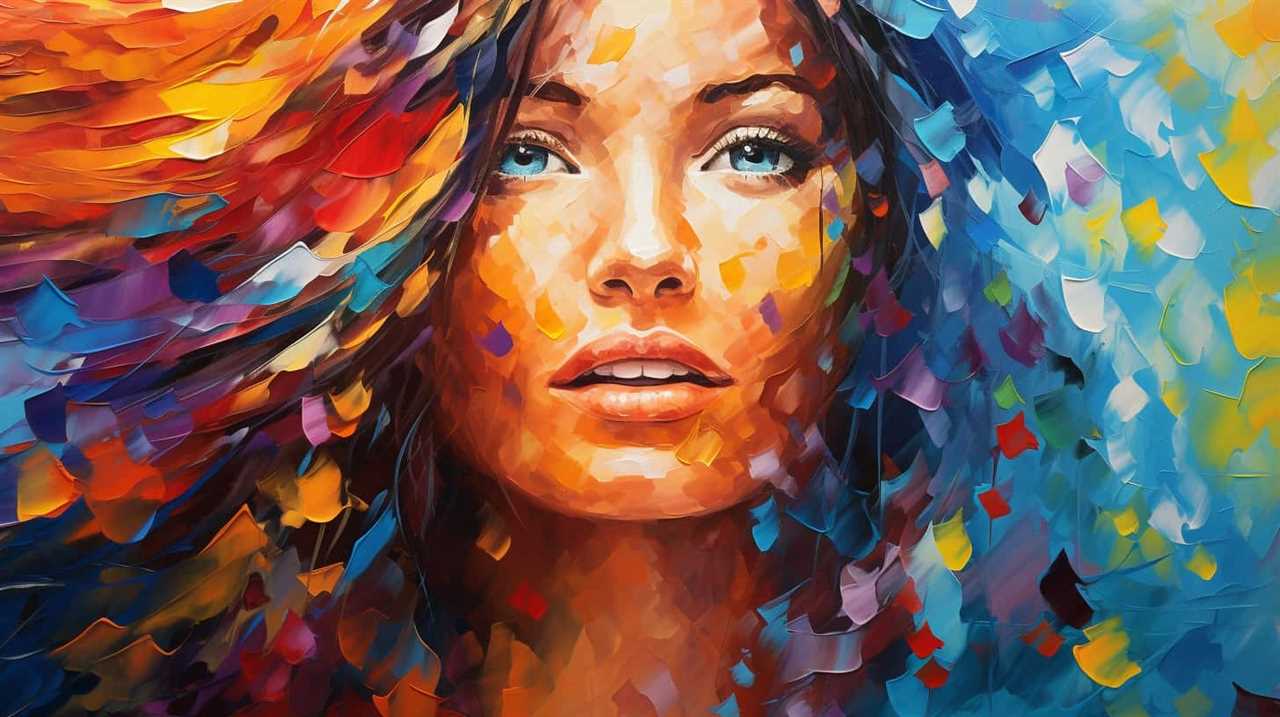
Internet art has blurred the traditional boundaries between art forms, allowing for new and unconventional modes of expression. It has challenged the notion of what’s considered art, pushing the boundaries of creative expression and inviting audiences to engage with art in innovative ways.
The internet has also democratized the art world, providing a platform for artists from diverse backgrounds to share their work and connect with a global audience. This has led to a greater diversity of voices and perspectives in the art world, breaking down barriers and creating a more inclusive artistic community.
In addition, internet art has opened up new possibilities for collaboration, allowing artists to collaborate across borders and create groundbreaking works that defy traditional categorizations.
Accessibility and Inclusivity
Through the emergence of internet art, technology has played a vital role in fostering accessibility and inclusivity within the art world. Digital accessibility has revolutionized the way art is experienced and shared, breaking down barriers that once limited participation.
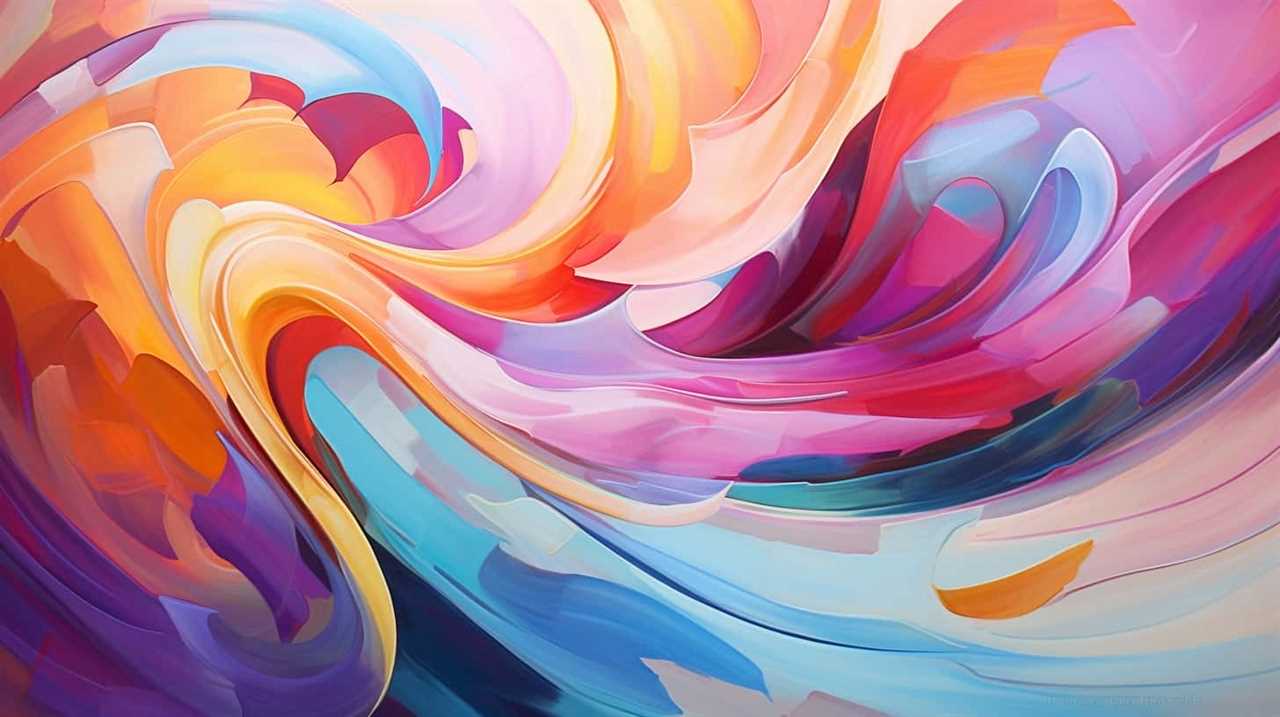
With the advent of online platforms and virtual exhibitions, art lovers from all walks of life can now engage with art from the comfort of their own homes, regardless of physical limitations or geographical location.
Inclusive art exhibitions have become more prevalent, showcasing the work of diverse artists and encouraging dialogue about social issues. The internet has provided a platform for underrepresented voices to be heard and celebrated, challenging the traditional norms of the art world and creating a more inclusive and democratic space for artistic expression.
As technology continues to advance, the potential for even greater accessibility and inclusivity in the art world is boundless.
Digital Vs. Traditional Mediums
As artists and art enthusiasts, our perspective on the impact of internet art versus traditional mediums is shaped by the dynamic interplay between digital and physical forms of artistic expression.
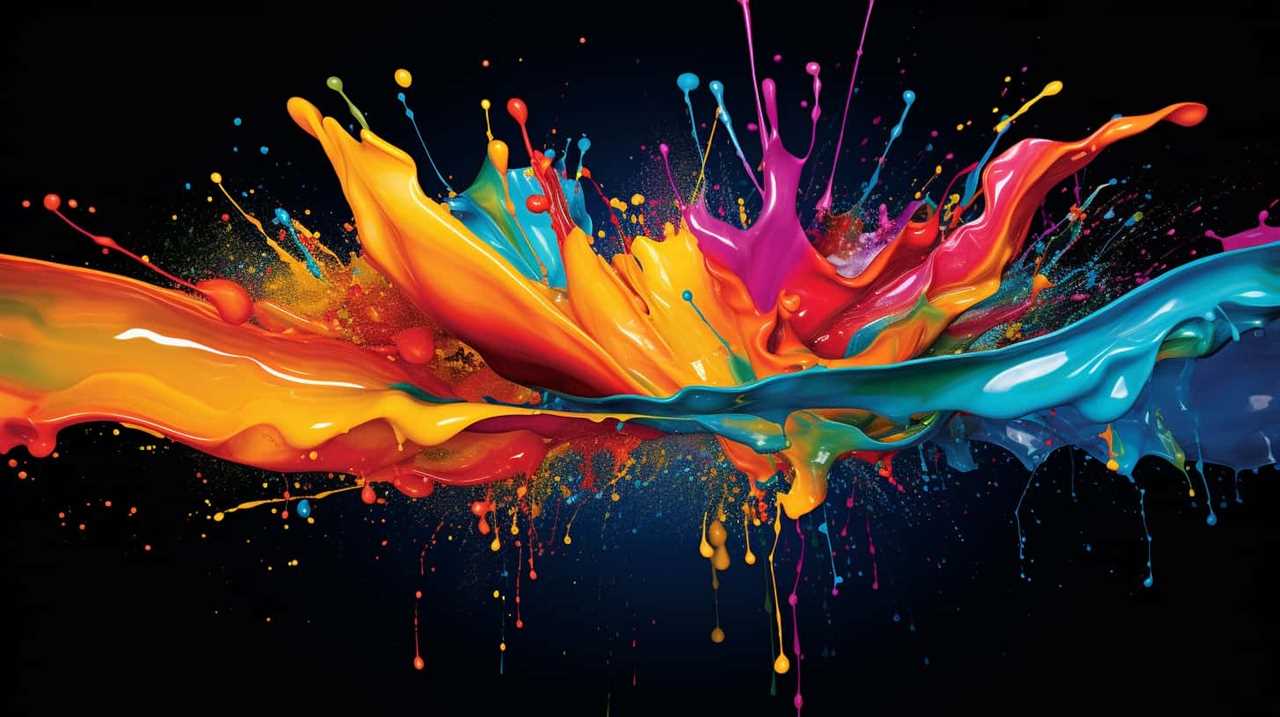
The rise of digital painting has revolutionized the way artists create and share their artwork. With just a few clicks, artists can experiment with different colors, textures, and techniques, pushing the boundaries of traditional painting.
On the other hand, traditional sculpture continues to captivate audiences with its tangible presence and tactile appeal. The physicality of sculpting allows artists to engage with their materials in a way that digital mediums can’t replicate.
However, the advent of internet art has brought about a new era of accessibility and global reach. Through online platforms and social media, artists can share their work with a vast audience, transcending geographical and cultural barriers. This has opened up opportunities for artists to connect, collaborate, and inspire one another in ways never before possible.
Thus, the interplay between digital and traditional mediums has enriched the art world by offering artists new avenues for creativity and communication.

Video Games as a Platform for Artistic Exploration
Using video games as a platform for artistic exploration offers a myriad of possibilities for engaging and immersive experiences. Virtual reality art experiences, in particular, have emerged as a groundbreaking medium that allows artists to create interactive and immersive worlds for audiences to explore. These virtual environments provide a unique opportunity for artists to experiment with new forms of storytelling and expression.
One of the key strengths of video games as an artistic medium is their ability to engage the audience in the narrative. Interactive storytelling in video games allows players to actively participate in the creation of the story, making choices that shape the outcome and influencing the direction of the game. This level of agency creates a sense of immersion and investment that’s unparalleled in other forms of artistic expression.
Moreover, video games offer a dynamic canvas for artists to explore a wide range of themes and concepts. From exploring social issues and political commentary to pushing the boundaries of visual design and aesthetics, video games provide a unique platform for artists to experiment and push the boundaries of artistic expression.
As we transition into the next section about bioart and its exploration of technology and biology, we’ll explore how artists are using technology and biological materials to create thought-provoking and innovative artworks.

Bioart and Its Exploration of Technology and Biology
In our exploration of video games as a platform for artistic exploration, we now delve into the realm of bioart and its fascinating intersection of technology and biology. Bioart, as an emerging field, pushes the boundaries of traditional art forms by incorporating living organisms and biotechnology into the creative process. This innovative approach raises important questions about the ethical implications of bioart and technology, particularly in the context of bioethics.
When considering the relationship between technology and bioethics, it becomes evident that bioart challenges our understanding of what it means to be human and the limits of scientific intervention. Here are two subtopics to further analyze the ethical implications of bioart and technology:
- Manipulation of Living Organisms: Bioart often involves the manipulation of living organisms, whether it’s genetically modifying plants or creating living sculptures using cells. This raises questions about the ethical boundaries of scientific experimentation and the potential consequences of altering the natural world.
- Ownership and Control: In bioart, artists often collaborate with scientists and researchers, leading to discussions about ownership and control over living organisms. Who owns the artwork created through bioart? Should artists have the right to patent genetically modified organisms? These questions highlight the complex relationship between art, science, and intellectual property rights.
As technology continues to advance, bioart will undoubtedly play a significant role in shaping modern art dialogue. By exploring the ethical implications of bioart and technology, we can foster a more informed and nuanced discussion about the intersection of art, biology, and technology in our rapidly changing world.
Data Visualization in Contemporary Art Discussions
Our exploration of contemporary art discussions now turns to the incorporation of data visualization.
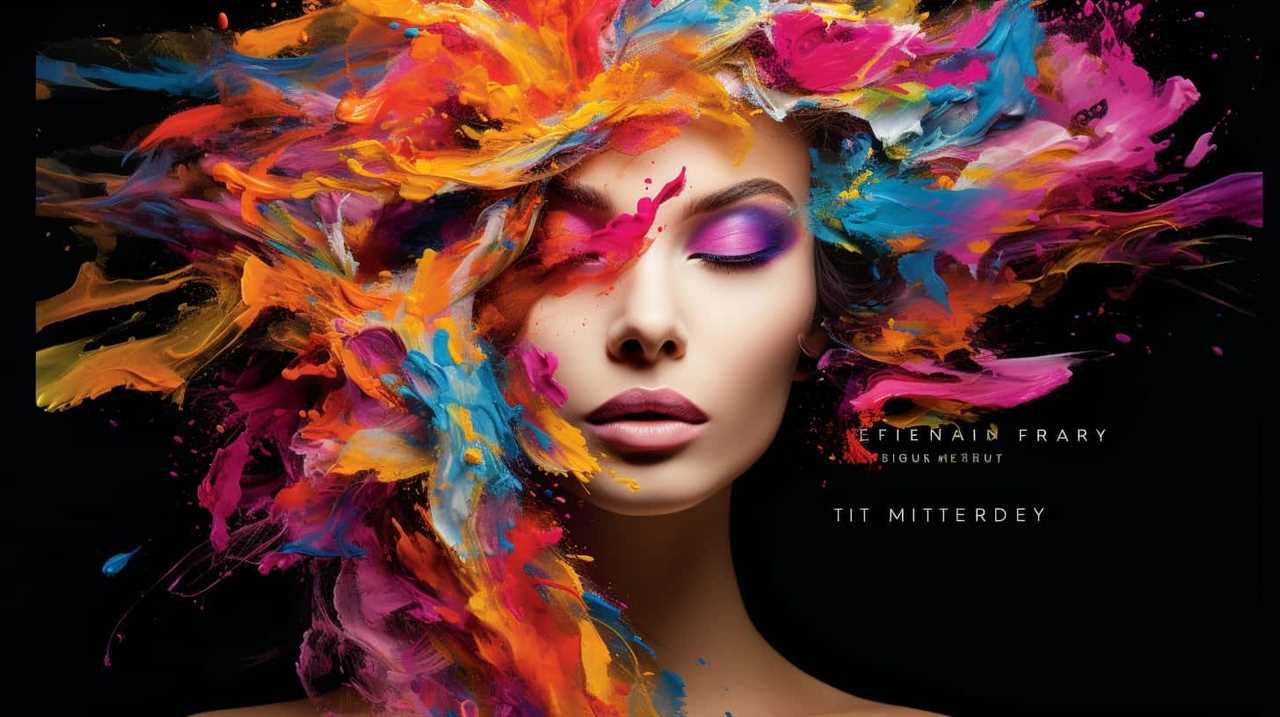
In today’s digital age, artists are utilizing data visualization techniques to create innovative and interactive art installations. Data visualization allows artists to transform complex information into visual representations that can be easily understood and interpreted by viewers.
Through the use of various visualization techniques such as graphs, charts, and interactive displays, artists are able to explore and communicate complex ideas and concepts in a visually compelling way. This not only enhances the viewer’s understanding of the data, but also creates an immersive and engaging experience.
One example of data visualization in contemporary art is the work of Aaron Koblin, who creates stunning visualizations using data from various sources such as social media, air traffic, and even DNA sequencing. By transforming this data into captivating visual representations, Koblin invites viewers to contemplate the vast amount of information that surrounds us and its impact on our lives.
Data visualization in contemporary art not only provides a new way of presenting information, but also challenges traditional artistic boundaries. It allows artists to merge science, technology, and art, pushing the boundaries of creativity and expression. By incorporating data visualization techniques into their work, artists are able to engage with audiences on a deeper level, sparking meaningful conversations and encouraging critical thinking.
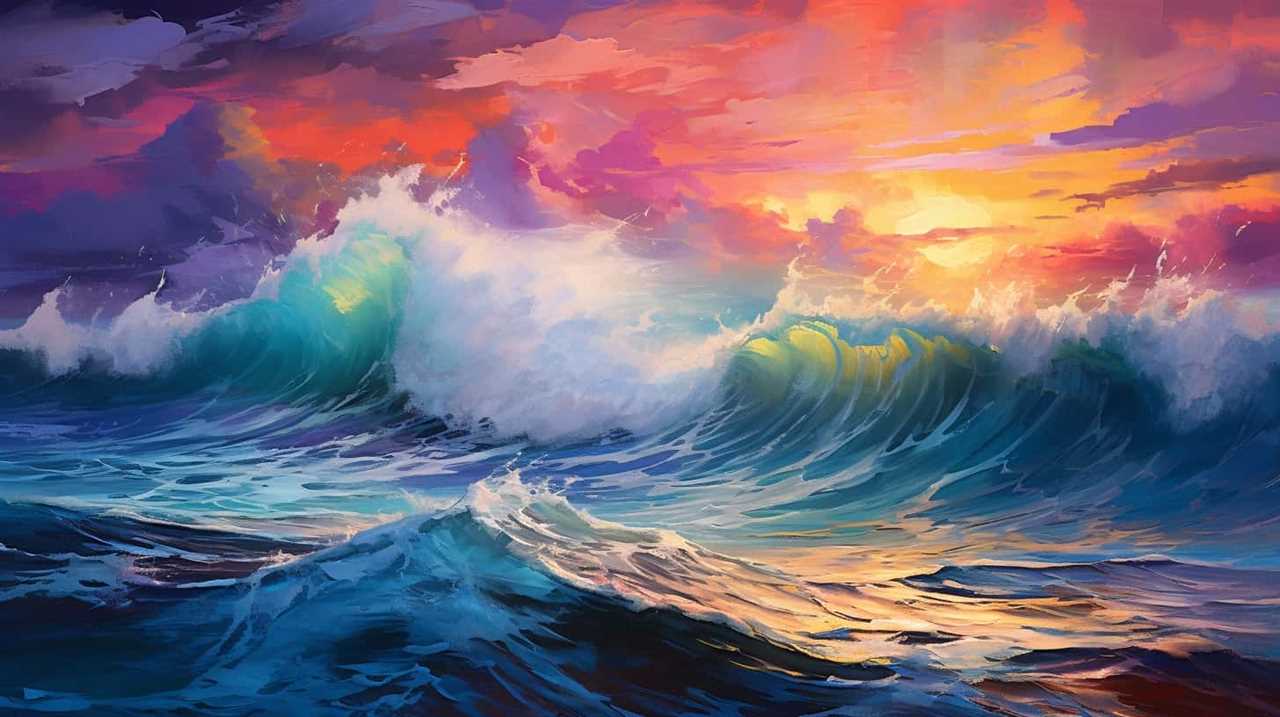
As we delve further into the impact of technology on contemporary art, we’ll now explore the role of robotics in redefining artistic boundaries.
The Role of Robotics in Redefining Artistic Boundaries
As technology continues to evolve, robotics have become valuable collaborators in the world of art, pushing the boundaries of what’s traditionally considered artistic expression. By incorporating robotics into the artistic process, artists are able to create works that challenge our preconceived notions of art forms, blurring the line between what’s human and what’s machine.
This redefinition of artistic boundaries opens up new possibilities for creativity, sparking a fascinating dialogue between human and machine creativity.
Robotics as Art Collaborators
Through the integration of robotics, we’re reshaping the boundaries of art and expanding the possibilities for collaborative artistic expression. Robotics as interactive installations and in performance art has revolutionized the way we perceive and interact with art.
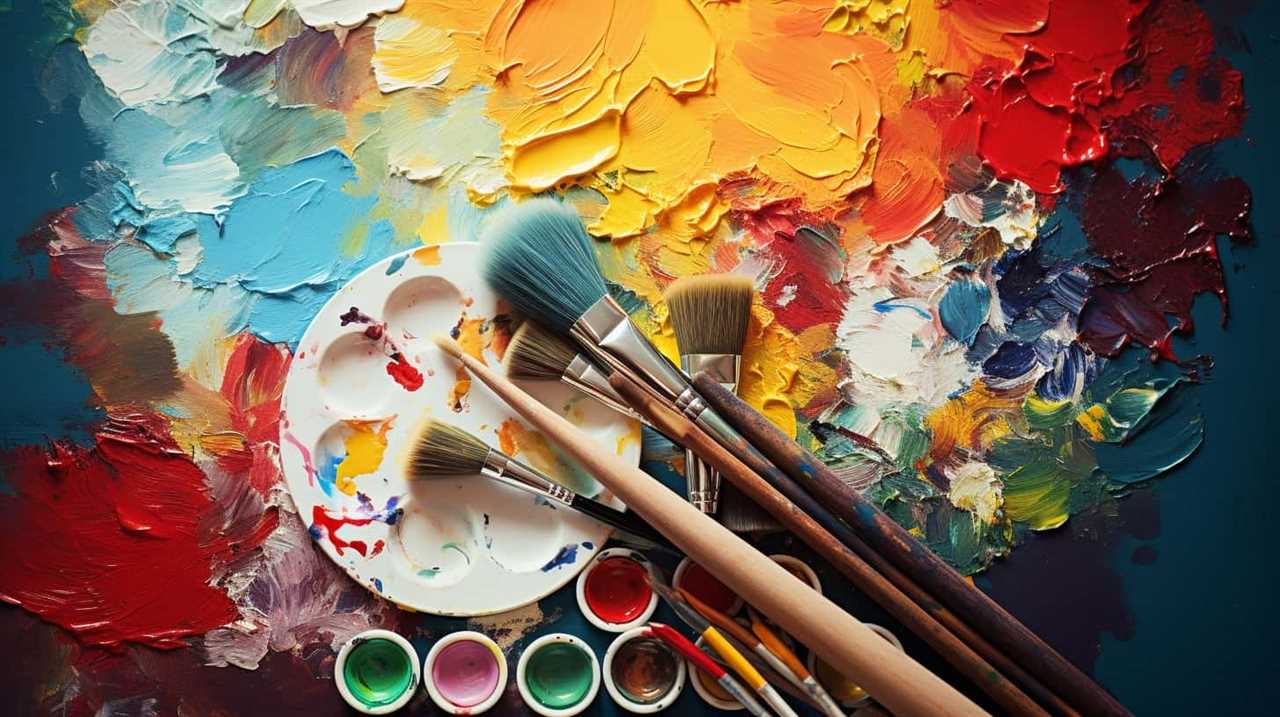
Here are some key ways in which robotics is redefining artistic boundaries:
- Interactive Installations:
- Robotics allows for the creation of immersive and interactive installations that engage the audience on a deeper level.
- Through the use of sensors and artificial intelligence, robots can respond to human presence and interaction, blurring the lines between the observer and the artwork.
- Performance Art:
- Robotics has opened up new avenues for performance art by introducing robotic actors and dancers.
- These robots can execute complex movements and choreographies, pushing the boundaries of human physicality and exploring new possibilities in artistic expression.
As we delve into the realm of robotics as art collaborators, we begin to break traditional art forms and venture into uncharted territories of creativity and liberation.
Breaking Traditional Art Forms
Robots have significantly transformed the boundaries of traditional art forms, redefining artistic expression in unprecedented ways. By reimagining sculpture and creating interactive installations, robots have challenged the conventional notions of what constitutes art. They’ve brought a new level of dynamism and interactivity to the art world, allowing viewers to actively engage with the artwork.
One example of this redefinition is the use of robotic arms to create sculptures. These robots, with their precise movements and capabilities, can shape materials in ways that were previously unimaginable. They can carve intricate details, manipulate different mediums, and bring abstract concepts to life. The result is a fusion of technology and art, pushing the boundaries of creativity and pushing the boundaries of what’s possible.

Another way in which robots have broken traditional art forms is through interactive installations. These installations invite viewers to become active participants in the artistic experience. Through sensors and programming, robots can respond to the viewers’ presence and movements, creating a unique and personalized experience for each individual. This interactive element not only challenges the passive role of the viewer but also blurs the line between the artwork and the audience.
Robots have truly revolutionized the art world by breaking traditional art forms and redefining artistic boundaries. Their ability to reimagine sculpture and create interactive installations has opened up new possibilities for artistic expression. However, while robots have brought innovation and creativity to the art world, there’s still a question of whether they can truly match the creativity and emotion of human artists.
Human Vs. Machine Creativity
One key aspect to consider in the role of robotics in redefining artistic boundaries is the comparison between human and machine creativity. As technology continues to advance, machines equipped with machine learning and creative algorithms are being developed to generate artistic works. This raises the question of whether machines can truly replicate the depth and emotion that human artists bring to their creations.
On one hand, machines have the ability to process vast amounts of data and learn from it, allowing them to create complex and intricate pieces of art.
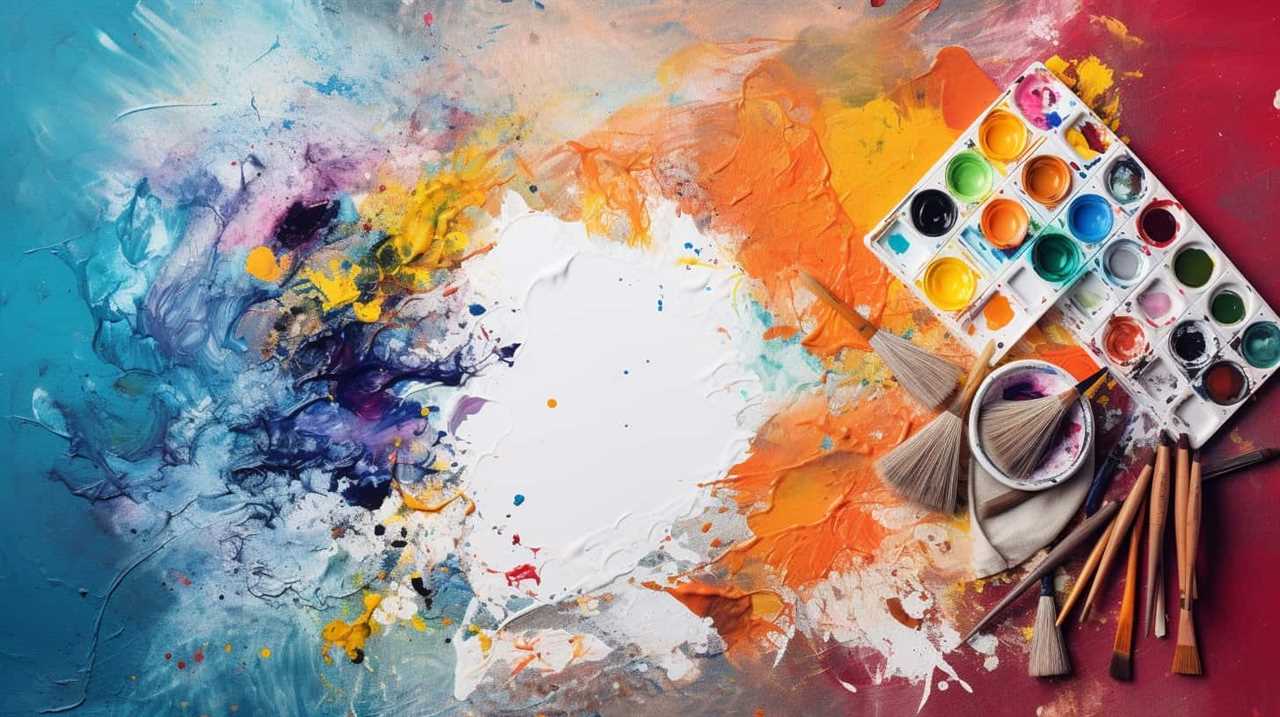
On the other hand, human creativity is driven by emotions, experiences, and unique perspectives, which machines may struggle to replicate.
While machines can produce impressive art, it’s the human touch that adds a layer of authenticity and personal connection. However, as technology continues to evolve, we may see a convergence between human and machine creativity, leading to new and exciting possibilities in the art world.
In considering the future of technology in shaping art dialogue, it’s important to explore how advancements in robotics and artificial intelligence will further redefine artistic boundaries.
The Future of Technology in Shaping Art Dialogue
We frequently utilize technology to actively shape the dialogue surrounding art. As we look towards the future, it’s clear that technology will continue to play a significant role in shaping art dialogue. The advancements in technology are opening up new possibilities for artists and audiences alike, revolutionizing the way we create and experience art.

One aspect of the future of technology in shaping art dialogue is the potential for immersive and interactive experiences. Virtual reality (VR) and augmented reality (AR) technologies are already being used to create immersive art installations and exhibitions. These technologies have the ability to transport viewers into new worlds, allowing them to engage with art in a completely different way. This not only enhances the artistic experience but also opens up new avenues for artists to express themselves and communicate their ideas.
Another area where technology will continue to shape art dialogue is through the use of artificial intelligence (AI). AI has the potential to revolutionize the way art is created and curated. Artists can now use AI algorithms to generate new ideas and explore different artistic styles. Additionally, AI can analyze vast amounts of data to curate exhibitions and recommend artworks to audiences based on their individual preferences and interests.
Frequently Asked Questions
How Has Social Media Changed the Way Artists Communicate and Engage With Their Audience?
Social media has revolutionized how artists communicate and engage with their audience. Artists’ online presence has become essential, allowing for direct interaction and global reach. The impact of hashtags has created new avenues for discovery and collaboration, transforming the art dialogue.
What Are Some Examples of Video Games That Have Been Recognized as Works of Art?
Some video games, like "Journey" and "The Last of Us," have been recognized as works of art due to their immersive storytelling and stunning visuals. Technology has allowed for new forms of artistic expression.
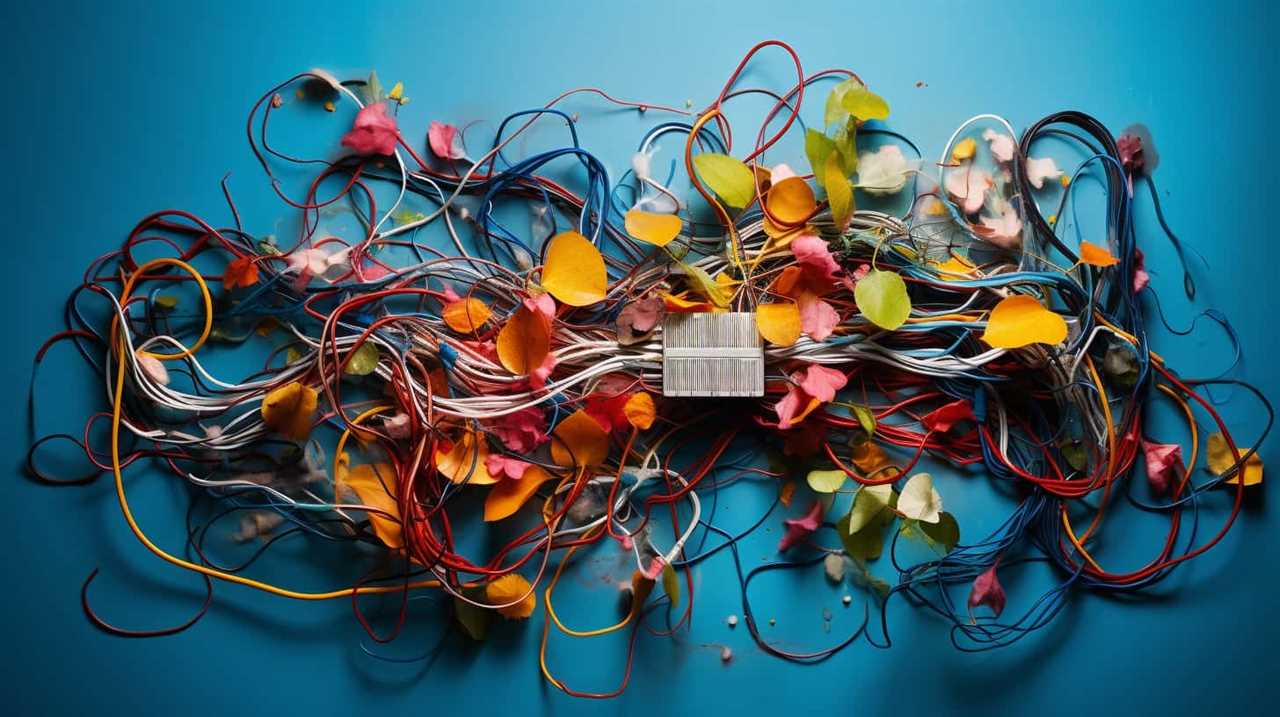
How Has Bioart Incorporated Technology and Biology in Its Exploration?
Bioart’s impact is evident in its incorporation of technology and biology. Through innovative exploration, artists have used technology to push the boundaries of artistic expression, creating thought-provoking works that challenge societal norms and liberate our understanding of the world.
Can You Provide Examples of Data Visualization Being Used in Contemporary Art Discussions?
Data visualization plays a significant role in contemporary art discussions. It allows us to analyze complex information and engage with art in a visually compelling way, expanding our understanding and challenging traditional narratives.
How Do Robotics Redefine Artistic Boundaries, and What Impact Does It Have on the Art World?
Robotics redefine artistic boundaries by merging technology and creativity, enabling interactive and immersive experiences. Artificial intelligence and virtual reality expand possibilities, challenging traditional notions of art. This impact on the art world ignites liberation and innovation.
How has technology influenced the way artists express themselves in the modern art world?
Technology has revolutionized the way artists convey their creativity. Social media platforms and digital tools have enabled artists to reach a wider audience and experiment with new forms of expression. With the help of technology, artists can share their work and inspire others with the best self-expression art quotes.
Conclusion
In conclusion, technology has played a pivotal role in shaping the dialogue surrounding modern art.

From the exploration of virtual reality and augmented reality as mediums for artistic expression to the influence of social media and data visualization on art discussions, technology has opened up new avenues for creativity and collaboration.
One interesting statistic to consider is that over 70% of artists now incorporate digital tools into their artistic process, highlighting the significant impact technology has had on the art world.
Lauren’s talent in writing is matched by her passion for storytelling. Her love for books and deep understanding of culture and entertainment add a distinct flavor to her work. As our media and press contact, Lauren skillfully bridges the gap between afterQuotes and the broader media landscape, bringing our message to a wider audience.
